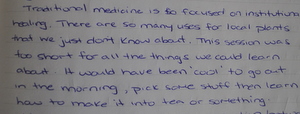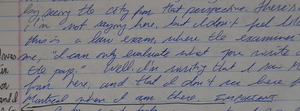In May 2010, five Law students — Arthur Ayers, Emily Conway, Justin Douglas, Joey Flowers, and Iona Fournier Tombs — took part in a field course alongside students from the Department of Anthropology and the School of Social Work.
The intensive two-week course explored restorative justice, Mohawk governance and contemporary challenges in aboriginal ways of life. Students spent the first week learning about issues from the perspective of the different disciplines and then camped at Kahnawake Mohawk Territory for five days while taking part in activities such as a sweat ceremony, a medicine walk and talks by Kahnawake residents. Below, excerpts from the journals and essays written throughout the course.
Reflections on studying Law alongside Social Work, Medicine and Anthropology

Justin Douglas It will be an interesting task to combine the legal discipline with medicine, anthropology and social work. So often, law isolates itself as a discipline. I’m going to need to reorient my thought process to be open to other ways of looking at the world. I like the idea of law as interdisciplinary. I don’t think specialization in one area leads to a balanced viewpoint. I’m excited to see the ways in which my conceptions of law will change after this course is over.
Iona Fournier Tombs I came to law school to make a difference in my community and in the world, not to make big bucks. Being around these social work students, anthropology students, is great because we talk about issues and get to share different solutions, different ways of seeing.
I like that the social work readings are up front about wanting to make things better, heal people. It’s not at all considered naïve… I like that we get to talk about that, about healing.
Emilie Conway C’est toujours amusant de voir comment le droit est présenté aux non-juristes. On revient à la base à une question comme ‘qu’est-ce que le droit,’ interrogation qui est beaucoup plus profonde qu’il n’y parait à même abord. Cela renvoie aux … même de la discipline et de la production de la connaissance.
Séance ce matin sur le travail social. La disposition de la classe a changé : nous sommes désormais en cercle, ce qui change radicalement l’atmosphère, et pour le mieux. Nous allons dialoguer, partager, c’est un véritable échange… J’aime le fait qu’en travail social, la subjectivité et la réflexivité soient encouragées. En droit, j’ai l’impression qu’il faille laisser notre bagages, notre expérience et nos impressions personelles au vestiaire car ils ne sont pas pertinents à l’augmentation juridique.
Arrival at Kahnawake
Justin Douglas The area that we are staying in is absolutely beautiful. In the three years I’ve attended McGill Law, I haven’t left the island of Montreal. Kahnawake is so close to the city that I’ve left behind, yet it is a different world.

Joey Flowers There’s a lot I’m not saying here but I didn’t feel like this is a law exam where the examiner tells me, “I can only evaluate what you write on the page.” Well, I’m writing that I saw Montreal from here, and that I don’t see here from Montreal when I am there. IMPORTANT. Note: I was biking in Lachine on May 30 and I tried to see Kahnawake from Lachine and couldn’t. I could see a boat passing through the seaway, though.
Emilie Conway L’endroit est tout simplement magnifique. Sa tranquillité est en contraste frappant avec le bruit de la grande ville toute proche, juste de l’autre côté de la rive. Assise au bord de l’eau, je vois au loin l’Oratoire St-Joseph et l’Université de Montréal. Malgré la proximité géographique, j’ai l’impression d’avoir pénétré dans un autre univers. Les règles de vie Mohawk qu’a énoncées Mike à notre arrivée me fait réaliser à quel point notre société occidentale s’est éloignée de l’essentiel, que notre rythme de vie effréné nous fait oublier. Le rapport au temps, aux autres qui nous entourent et à la nature sont si différents dans la culture et la philosophie autochtones.
Iona Fournier-Tombs

Loons!
The view is stunning from the shore. I’ve never seen the city from this angle. It’s a lot easier to imagine life here 300 years ago, to imagine Montreal in a way I’ve never seen it before, even though the water is so polluted and there are huge ships passing by.
…
Plants, Nature, Medicine Walk
Justin Douglas We had been camping on the sit for 4 days before Darryll walked us around and explained some of the traditional uses for many of the plants around us. It made me feel so ignorant to all the nature around me. We hear stories of pharmaceutical companies venturing deep into the Amazon rain forest to find new cures. There is so much potential for healing and benefit from the things that grow right here.
Emilie Conway Après le diner, nous nous sommes rendus dans les locaux adjacents au centre communautaire pour assister à une présentation sur l’importance de la fraise dans la culture Mohawk. Les Iroquois font une analogie entre la fraise et le cœur d’un enfant naissant (même grosseur, même couleur et les deux sont portés par l’homme qui les cueille).

Iona Fournier Tombs A list of plants discovered on the medicine walk:
Willow – inner bark reddish – in hot bath, water turns red, or better boil it. Like a big massage, it takes away soreness. Also used in sweats – steam.
Strawberry
Horsetail (grows with willow). Aching tendons, joints and muscles. Rinse hair after shampoo, for hair growth. (Stinging nettle, too.)
Sumac. Prevent miscarriage – sumac strengthens the womb.
Trillium – white and red (purplish); women’s medicine. Dangerous b/c not many ppl know how to use it.
Wild black raspberry – for women. Plant, roots, berry, stems, soothing.
Dandelions: pick before flower, when still in bulb. Pick all leaves around it, otherwise too tough to eat.
Dogwood (red willow) – antiseptic properties.
Jack in the pulpit – only use when dried out with shiny fruit; otherwise, very toxic and can’t touch it.
Fiddleheads – boil twice, otherwise toxic
